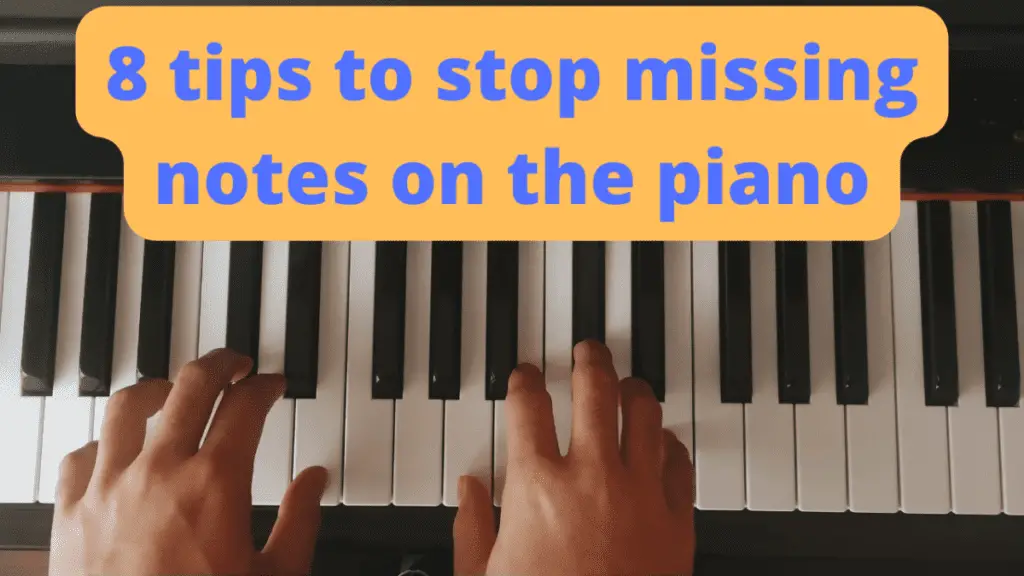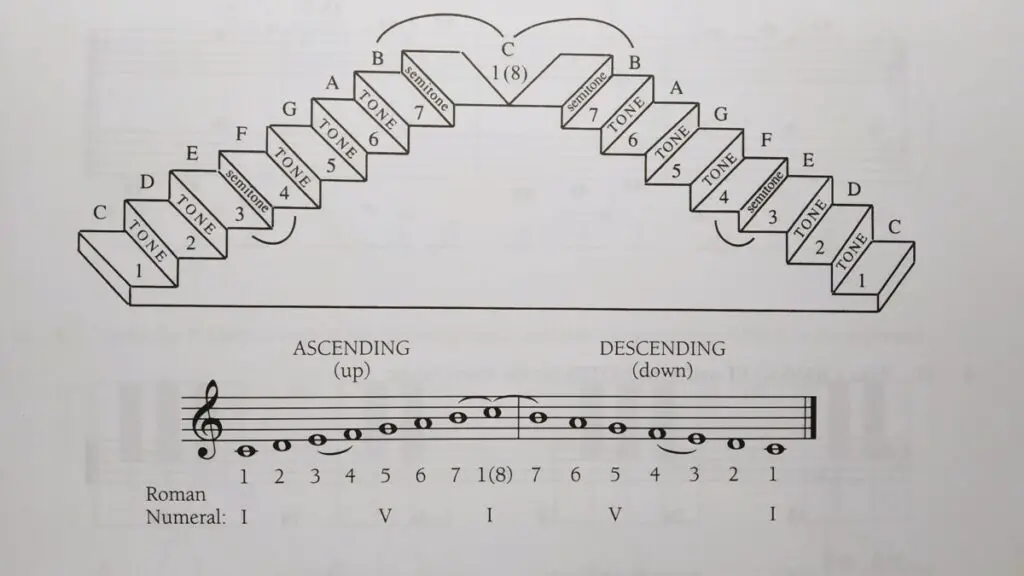This post contains affiliate links.

When practicing a piano piece, you might make mistakes and your fingers miss some notes. However, no matter how many times you practice, you keep missing the same notes over and over and it’s frustrating you. So what should you do to stop missing notes on the piano?
Here are my 8 tips to stop missing notes on the piano:
- Practice scales to make your fingers more accurate
- Practice triads and their inversions
- Clean piano keys to make them less slippery
- Practice pieces at a slower tempo
- Practice 2 hands separately first
- Try a different fingering than the one suggested by the piece
- Focus on the hard passages that are giving you trouble
- Learn easier pieces since the current piece is too hard for you
With the tips listed out, you may wonder how exactly will they help you stop missing notes when playing piano pieces? I will answer that question in this article and also discuss the reason why missing a couple of notes when playing isn’t the end of the world and you shouldn’t beat yourself too hard over it.
How to stop missing notes on the piano
Practice scales
For anyone that doesn’t know, a scale is a collection of successive notes that starts on a particular note and ends on that same note but one octave higher. There are different types of scales like Major or minor. Within minor, there are natural minor scales, harmonic minor scales and melodic minor scales.
For example, the C Major scale starts on C and ends on the C next to it on the piano keyboard, including all the white notes in between:

Many scales have awkward and difficult fingerings like playing notes between black keys in succession or tucking your thumb under to shift your fingers to play all the notes in two octaves, etc.
What this means is that by practicing scales, you’re training your fingers to accurately hit notes next to each other with no slips. Eventually, the motion will be second nature to you and you can play all notes in a scale accurately with your eyes closed.
The goal of practicing scales is to be able to play them with no mistakes at a fast tempo, this makes it even less likely for your fingers to miss notes.
If you are hesitant about practicing scales because you don’t want to learn the music theory behind scales, it’s ok to not learn the theory and instead imitate playing the scales using Youtube videos. Practicing scales is more about improving your techniques than about learning music theory.
Aside from helping you hit notes accurately, practicing scales can also make your fingers stronger, less stiff and more nimble in general, improve your improvisation skill, prepare you for pieces with scales in them, etc. I list more benefits of practicing scales in the article 9 Reasons Why You Must Practice Scales and Arpeggios
Practice triads and their inversions
Triads in music theory is a set of 3 notes where the 1st and 2nd notes are 3 notes apart and the 2nd and 3rd notes are 3 notes apart. For example, one triad in the C Major scale is C-E-G, this is called a tonic triad.
A triad inversion is where you take the first note of the triad and shift it an octave up (so the next key on the piano with the same note). You can do this two times (1st inversion and 2nd inversion) before you return to the original triad.
For example, this is what a C Major triad and its inversions look like on the piano:
Practicing triads and their inversions will help your fingers get used to awkward fingerings like practicing scales does. It’ll also help build your spatial awareness of the piano keyboard, making it easier to know the positions of all keys, which in turn helps your fingers hit notes accurately.
Clean piano keys
Piano keys nowadays are made of plastic which is more slippery compared to pianos with ivory keys. Ivory keys are made from elephants’ tusks and rhinos’ horns and so they’re banned nowadays.
Plastic keys combined with oil and sweat that are coming from your fingers when playing makes the keys even more slippery. This makes it easier for your fingers to accidentally slip. Not to mention the fingerprints that are left on the piano keys which make them ugly.
This is why I like to wipe my piano keys with a wet microfibre cloth every time I’m done practicing piano, especially since I have oily hands.
But what about other cleaning agents like Windex, baking soda, and baby wipes? Check out this article to find out whether they’re safe to use on your precious piano keys.
There are many more things that can cause slippery keys, like hands that are too oily or hands that are too dry. I talk about how to fix those issues so your fingers always have a firm grip on the keys Tips to Stop Your Fingers From Slipping Off Piano Keys
Practice pieces at a slower tempo
You may be tempted to practise a piano piece at the tempo suggested. However, it’ll be more efficient if you practice the piece at a slow tempo first and gradually increases the speed. This makes sure that you learn proper fingerings and get them right first before playing the piece quickly.
Practicing at a slow tempo makes it less likely for you to miss notes or hit wrong notes since you’ll have enough time to process which notes you need to hit next.
If you’re still missing notes at a slow tempo, then practice the piece at an even slower tempo. Go so slow that you won’t even recognize the piece when playing it.
Once you can hit the notes accurately at a slow tempo, then you can start practicing at a higher tempo. Remember that if you can play a piece slowly, you can play that piece quickly.
Practice two hands separately
If you continue missing notes, it could be because playing with two hands is too much for you at the moment. Thus, practice each hand separately so you have fewer notes to remember and deal with.
Once you get each hand playing accurately, then you can combine them and play together.
Try a different fingering than the one suggested
Currently, you are either using the fingerings recommendations written on the sheet music or copying the fingerings you see in a Youtube tutorial video of the piece. However, this may be the reason why you’re missing notes in the first place.
Each person’s hands and fingers are different: some have smaller hands while others have bigger hands. Some people have long fingers while others have short fingers. This means you should be flexible and play the piece with finger positions that are the most comfortable and natural to you.
Playing with uncomfortable fingerings creates an unnecessary challenge for yourself since you’ll have to deal with awkward fingerings that aren’t suitable for your hands and fingers.
Focus on the hard passages
If you keep missing notes, it could be because that particular passage of the piece is difficult for you. Thus, you should spend more time repeating that passage until you can hit all notes in that passage accurately.
With that said, generally, to make sure you don’t miss any notes while playing through the piece, you need to keep practicing the piece until you can play with your eyes closed.
You will need more practice as long as there’s still a millisecond of doubt where you’re trying to remember fingerings or what notes to hit next.
Personally, I need to practice any piece at least a dozen times before I’m fluent with it.
Practice also makes you less nervous when you have to play the piece in front of an audience, be it a recital, in front of family members or your teacher. We all experience this phenomenon: we can play the piece just fine when practicing but the moment someone is watching, we mess up and hit the wrong notes.
Pro tip: to get that feeling of someone watching over you when you’re practicing the piano, consider recording your session. The thought of being recorded at the back of your head can emulate the feeling of someone watching you play pretty well.
Choose easier pieces to learn first
While you can overcome many difficult pieces and stop missing notes by putting more time into practicing it, sometimes, the piece is simply too hard for your level currently and so you will keep making the same mistakes over and over again.
Pieces that are too hard have elements that you don’t have the necessary technical skill to play properly. Thus, it will be more beneficial for you to build up said skills by playing pieces closer to your level.
Furthermore, during the time spent struggling with a difficult piece, you could have learned many easier pieces that will contribute more to your skills.
I wrote an article to help identify if your piano piece is too hard for you currently How to Know if a Piano Piece is Too Hard For You
Missing a couple of notes isn’t that bad
If you’re only hitting a few wrong notes here and there throughout the piece that can be ironed out with enough practice, then it’s not something you should beat yourself over and get unnecessarily frustrated.
Know that for the more difficult pieces with fast tempos and crazy fingerings, it’s almost unavoidable to miss a few notes throughout the piece. Even concert or competition-level pianists still miss some notes while performing difficult pieces.
Take the example of pianist Martin Garcia Garcia’s performance during the Chopin Competition:
There are some parts during the performance where he hit the wrong notes. However, as a member of the audience listening, it’s difficult to pinpoint exactly where he made the mistake. This is because he continued playing as if he made no mistakes in the first place.
So even if you miss some notes when playing, continue playing as if you made no mistakes. If you do it well enough, the audience won’t even notice. However, if you pause or hesitate when you hit the wrong notes, the audience will notice that immediately.

